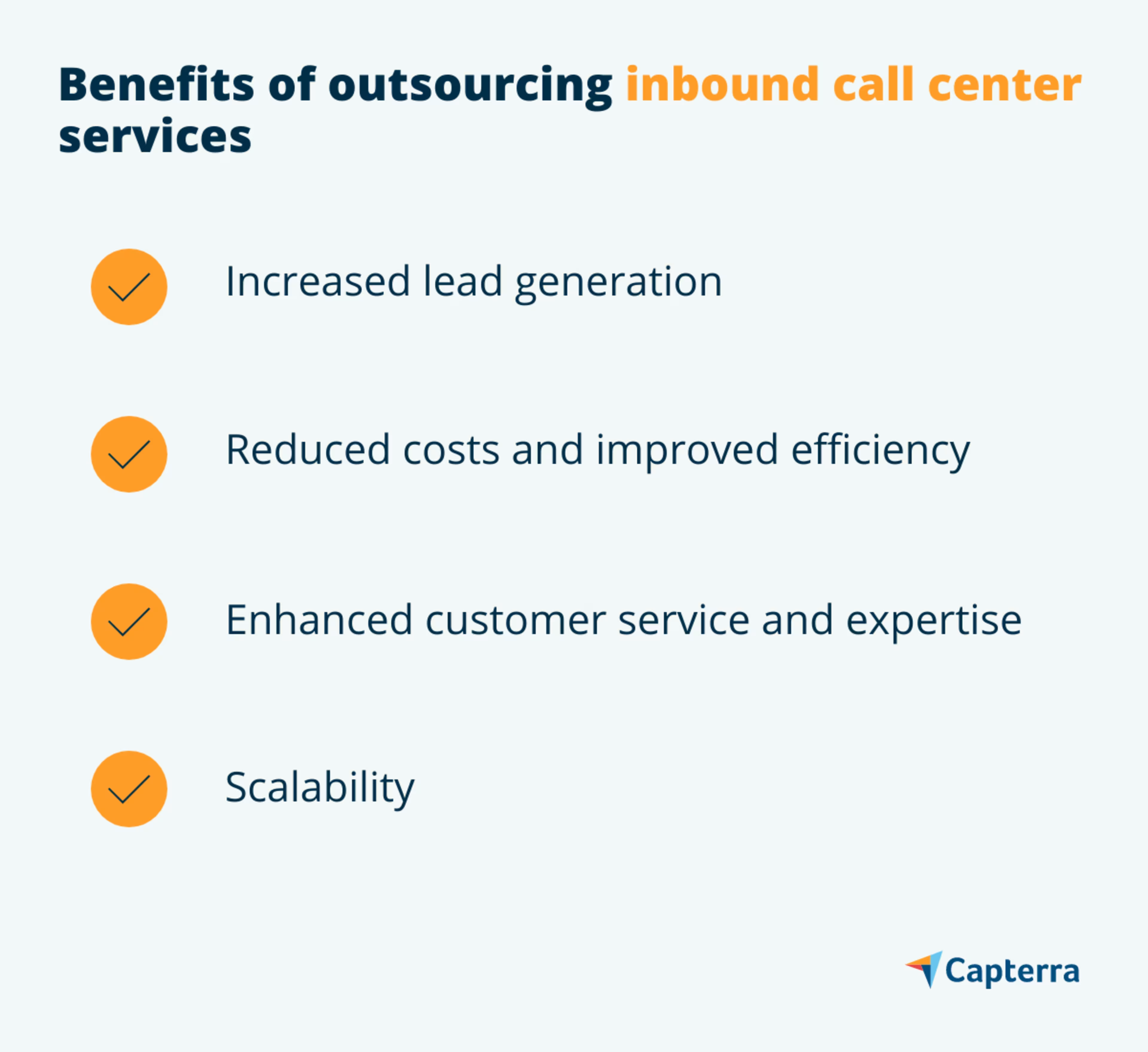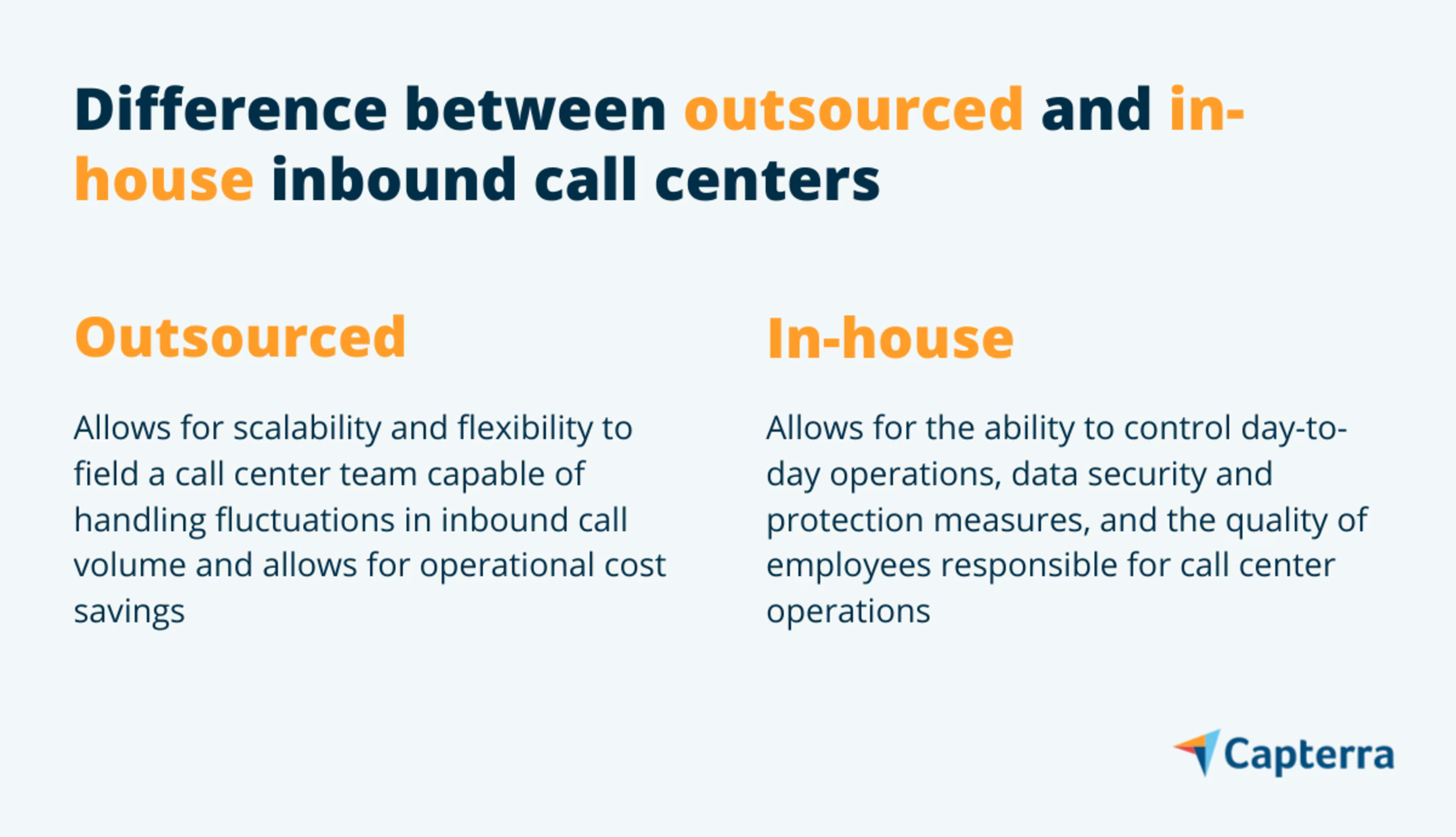Discover benefits of inbound call center outsourcing to enhance customer journey
In a recent article, Capterra explored the various types of call centers and the roles each type played in the overall success of small businesses. In this article, small business owners and customer service professionals interested in making improvements to their customer journeys can follow along as we take a deeper look at inbound call centers. If you’re handling client phone traffic, you’ll want to discover the benefits of an inbound call center, what function they fill in lead generation, and the signs that you should consider outsourcing to a service provider.
What does an inbound call center do?
Inbound call centers can be handled as an in-house business process or can be outsourced. While there are dedicated call center service providers, many managed services have pivoted to a contact center as a service (CCaaS) provider model in order to provide a full range of services.
In both cases, inbound call centers handle incoming calls from customers or potential customers. Inbound call center agents handle product inquiries and information requests. For small business owners, a call center can improve and augment the customer journey by providing a reliable point of contact for resolving issues as efficiently as possible.
What are the benefits of hiring an inbound call center?
Consolidating the responsibility for managing and handling inbound calls as a business process to a contact center provides a host of benefits to an organization.

Increased lead generation
The purview of inbound call centers extends beyond existing customers. They can also be tasked with handling inbound service and product inquiries from leads sourced through your social media content, paid advertising, and SEO efforts. In exchange for providing a superior experience at the call center level at this stage, studies show 77% of callers will be willing to provide their personal data for future follow-up.[1]
The leads captured by the call center can be fed into the company’s lead-tracking customer relationship management (CRM) database and targeted in follow-up marketing efforts, such as direct outreach from an outbound center, retargeting using paid advertising channels, and email campaigns. This approach to customer service in your call center ensures your team is capturing lead data that might be missed if they were reaching out to staff directly.
Reduce costs and improve efficiency
Referred to as first call resolution (FCR), many call centers strive to resolve a customer concern or complaint on the first call. A strong FCR is 71% or higher, which is indicative of the efficiency a well-trained team can achieve in problem solving and reducing costly follow-up communication.[2]
Another important metric tracked by call centers is the average handle time (AHT), or the average time it takes an agent to fully address a caller’s concerns. A low AHT allows agents to maximize the customer experience and can be achieved by providing agents with a comprehensive topical database agents can use to quickly address the needs of callers.
Together with a strong FCR, a low AHT injects efficiency into your customer service cadence that leads to lower costs in customer service and retention efforts.
Enhanced customer service and expertise
Call centers allow businesses to gather important customer feedback as part of the service experience. Once agents have engaged with and handled a caller’s concerns, the company can prompt the caller to complete a survey on the phone or via email. This feedback, often presented as an overall customer satisfaction score (CSAT) that should average between 75%-85%, allows businesses to gauge satisfaction levels and opportunities for improvement.[3]
Inbound call centers track several other metrics to ensure the customer experience meets caller expectations. Inbound centers generally rate their agents’ performance on the number of calls they field within a certain time frame, as long wait times indicate to call center leadership that additional staff or changes in procedure might be warranted.
For example, the call center might set a goal that 90% of calls must be answered within 30 seconds of being placed on hold by the automated intake system, and use that goal as a way to determine if customer needs are being met by the current system.
Scalability
Without an inbound call center in place, your team’s ability to respond to inbound calls is limited to your existing team’s bandwidth. Customer wait times to speak with experienced staff might exceed their expectations and create a negative perception of your brand. In conjunction with other factors, this could prevent growth over time and even result in lost business.
Call centers, especially those that are outsourced, provide an inbound call solution that can scale with your business needs while ensuring a consistent level of customer service and engagement. This can be especially useful if your call volume fluctuates regularly due to seasonality in your business or if you often launch new services and products.
Outsourced vs. in-house inbound call center services
As with any outsourced business process, the decision of whether to run your inbound call center in-house or through a third-party CCaaS provider depends on which of the models provides your business the most beneficial arrangement.

Scalability versus greater control
By outsourcing your inbound call center operations to a third-party, businesses sacrifice the ability to control day-to-day operations, the quality of the employees working in the call center, and the ability to control costs at a granular level. In exchange, they gain the scalability and flexibility made possible by a CCaaS provider in order to field a call center team capable of handling any fluctuations in inbound call volume that might arise.
Greater control over data security
Call centers are crucial sources of data collection. That data is facing increasingly stringent regulatory requirements dictating data security and usage due to the passage of the European Union’s General Data Protection Regulation (GDPR), California’s Consumer Privacy Act (CCPA), and similar privacy laws passed or pending legislative review throughout the United States.
While call centers often have centralized security and safeguards in place for client data, it’s crucial you understand how your industry is impacted by regulatory requirements, as some industries require very specific data protection measures to be taken. For example, in some situations, data cannot be stored in a shared database such as those that are often used by managed service providers. In these situations, it might be necessary to house and manage your call center in-house.
Operational cost savings versus cultural alignment
The overhead costs associated with establishing a call center in-house can be overwhelming for your average small business and start-up. Consider that your average call center would require the business to shoulder a slew of additional costs, from facility costs to the costs associated with the acquisition and upkeep of the necessary technological infrastructure. There are also the costs associated with hiring, training, and maintaining a management team and staff large enough to handle your call volume.
While CCaaS providers are at an advantage because they’ve built these costs into their service model, they are at a disadvantage as a service provider in that they aren’t immersed in the day-to-day culture of their clients, and this might come across in the quality of the service they provide to callers. An inhouse call center ensures the company’s call center agents are aligned with the culture, mission, and values that are most important to the brand.
Signs you should outsource inbound call center services
While there might be benefits to running your inbound call center in-house with existing resources, it’s becoming more rare for businesses who can field less than a thousand call center agents to invest in the necessary call center infrastructure.[4] Alongside the need to maximize the customer experience and limited staff or resources, this shift towards outsourcing has led to staggering growth in the CCaaS provider industry, with recent data showing that the CCaaS segment is a nearly $9 billion market growing at 19%.[5]
While we’ve talked about the benefits CCaaS providers bring to the table, you might still be asking yourself what are the signs you should consider outsourcing your inbound calling services rather than investing in an internal solution?
Is your staff overwhelmed with call volume to the point that wait times are out of control?
Consumers calling your company are looking to have questions answered, get technical support, set an appointment or place an order, or receive around the clock support for services they pay for. And they expect to accomplish these tasks spending a minimal time on hold before talking to an agent—in fact, anything over two minutes will result in overall lower customer satisfaction scores [6]. This sensitivity to wait times translates into 57% of customers feeling that long hold times are the most annoying aspect of dealing with a customer service call line.[7]
Outsourcing to a CCaaS provider for inbound calling minimizes wait times and ensures the team dedicated to handling your callers will scale accordingly.
Do you have the resources to provide call support around the clock?
It’s no longer enough to provide customer support during normal business hours. A globalized economy focused on ensuring consumers can get anything they want on-demand means that your business must be able to field customer inquiries around the clock. Absorbing the costs to maintain the staff and infrastructure to support a call center that operates 24 hours a day, seven days a week isn’t sustainable.
Outsourcing inbound call services ensures a consistent customer experience with a representative of your business regardless of the time of day.
Do your inbound call metrics indicate a healthy customer experience?
If you’re tracking your service levels alongside other KPIs such as AHT, CSAT, and FCR, you should have a fairly informed view of what the customer experience looks like. If your CSAT scores are low, and you’ve got customers having to call multiple times to resolve their issues, and it’s taking agents a significant amount of time to resolve customer issues, you might not be equipped to provide a healthy customer experience via your inbound call practices.
Inbound call centers are equipped to track KPIs related to their performance in providing a positive customer experience. In the event those KPIs aren’t to a client’s satisfaction, they have the resources and tools to adapt their approach and practices to ensure that the customer experience improves.
Are you tracking and analyzing your inbound calls and the customer experience?
Chances are, as a small business, you might not actually be tracking any of your KPIs related to the customer inbound call experience. You might not have the time or resources to dedicate to properly assessing your customer service data, or you might not even be collecting meaningful data through CRM tracking and surveys. An inbound call center can help you establish a system for tracking and monitoring client satisfaction.
In outsourcing your inbound call center services, you can tap into the valuable insight the data gathered by a well-established service provider in order to close the gap between customer expectations and the services you’re providing.
Finding Inbound call center tools and services
As a small business owner, protecting the customer experience is crucial to your ongoing success and ability to remain competitive in your industry segment. One of the most important things you can do to maximize the customer experience is to ensure customers can reach your business when they have questions or problems, and be able to provide them with the solutions or resolutions they need.
If you’re struggling to accomplish this with your current infrastructure, but you’re not able to or willing to invest in an in-house solution, consider exploring Capterra’s directories to explore call center service providers or options for purchasing a call center software system:
Make answering inbound calls a priority in 2024
In this article, we’ve run through the benefits of outsourcing your inbound call center needs to a third party service provider. Crafting a high-quality customer service experience takes having the right tools in place to ensure existing and potential customer needs are addressed to their satisfaction on a timetable that meets their expectations.
As you consider partnering with one of our expert partner agencies that specialize in inbound call center services or purchasing a software solution that meets your needs, expand your knowledge of inbound call centers with these other Capterra resources:

